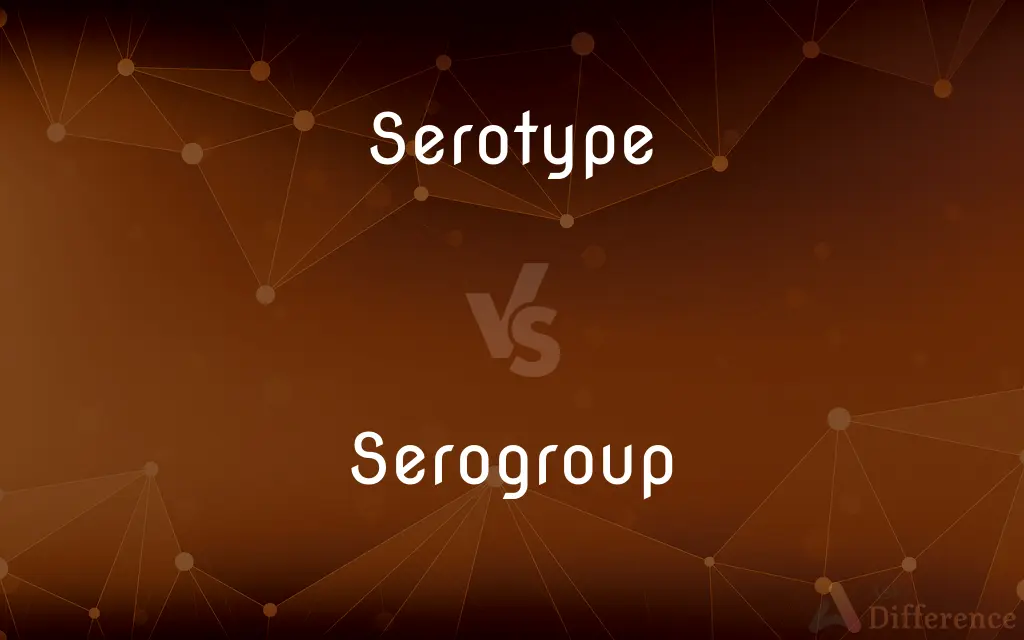Serotype vs. Serogroup — What's the Difference?
Edited by Tayyaba Rehman — By Fiza Rafique — Updated on March 27, 2024
Serotype refers to a distinct variation within a species of microorganisms or viruses identified by its specific surface antigens, while Serogroup groups together closely related microorganisms that share common surface antigens.

Difference Between Serotype and Serogroup
Table of Contents
ADVERTISEMENT
Key Differences
Serotype is defined by the unique combination of antigens present on the surface of a cell or virus, which allows for precise identification and differentiation within a species. Whereas, a serogroup is a broader classification that groups together various serotypes sharing certain antigenic properties, indicating a level of relatedness among them.
While serotyping is a finer method of classification that can be critical for identifying specific strains of bacteria or viruses for diagnosis or epidemiological tracking, serogroups serve to simplify the classification of microorganisms into broader categories. This distinction can influence vaccine development and the approach to treatments, as targeting a serogroup could offer broader protection against multiple serotypes.
Serotype identification is often essential for determining the virulence, or disease-causing potential, of specific pathogens and their susceptibility to antibiotics or antivirals. On the other hand, understanding serogroups can help in identifying potential cross-reactivity among vaccines or in predicting the emergence of new virulent strains within a group.
The concept of serotype is especially important in the study of bacteria and viruses that exhibit high variability in their surface antigens, such as Streptococcus pneumoniae, which has over 90 serotypes. Serogroups, however, are particularly useful in the initial stages of research or in public health surveillance, where detailed differentiation may not be necessary or practical.
In practical applications, the identification of a serotype can lead to specific interventions, such as the use of a targeted vaccine or treatment regimen. Conversely, identification of a serogroup might lead to broader, more general public health responses aimed at a wider range of related pathogens, illustrating the complementary roles of these classifications in disease management and prevention.
ADVERTISEMENT
Comparison Chart
Definition
A distinct variation within a species identified by specific surface antigens.
A collection of serotypes that share common antigenic features.
Classification Precision
Finer, more specific
Broader, more general
Application
Critical for precise diagnosis, tracking, and vaccine development.
Useful for initial research and broad public health strategies.
Importance in Research
Essential for understanding virulence and treatment susceptibility.
Important for identifying potential cross-reactivity among vaccines.
Example
Streptococcus pneumoniae has over 90 identifiable serotypes.
The Neisseria meningitidis A, B, C, W, and Y serogroups.
Compare with Definitions
Serotype
Specific antigenic composition.
The H1N1 serotype of the influenza virus is identified by its specific hemagglutinin (H1) and neuraminidase (N1) antigens.
Serogroup
Simplifies microbial classification.
Serogroups provide a broader overview of bacterial diversity.
Serotype
Used in epidemiological tracking.
Tracking the spread of the Dengue virus serotype 2 helps in managing outbreaks.
Serogroup
Useful in broad-spectrum vaccines.
Meningococcal vaccines target multiple serogroups of Neisseria meningitidis.
Serotype
Determines pathogen virulence.
Certain serotypes of E. coli, like O157.H7, are known for their high virulence.
Serogroup
Helps in understanding genetic relatedness.
Serogroups indicate a level of genetic relatedness among different serotypes.
Serotype
Critical for vaccine development.
Vaccines are often developed to target specific serotypes of pathogens.
Serogroup
Aids in initial public health response.
Identifying a serogroup can quickly guide public health measures during an outbreak.
Serotype
Variability within species.
The bacterium Salmonella has multiple serotypes, each causing different types of illnesses.
Serogroup
Groups related serotypes.
The serogroup O104.H4 of E. coli includes strains with similar antigenic properties.
Serotype
A serotype or serovar is a distinct variation within a species of bacteria or virus or among immune cells of different individuals. These microorganisms, viruses, or cells are classified together based on their surface antigens, allowing the epidemiologic classification of organisms to the subspecies level.
Serogroup
A group of microorganisms only differing from others by their composition in terms of antigens
Serotype
A group of closely related microorganisms distinguished by a characteristic set of antigens. Also called serovar.
Serogroup
To identify and characterize such groups
Serotype
To classify according to serotype; assign to a particular serotype.
Serotype
(immunology) A group of microorganisms characterised by a specific set of antigens.
Serotype
To assign or classify according to serotypes
Common Curiosities
What is a serotype?
A serotype is a distinct variation within a species of microorganisms or viruses, identified by specific surface antigens.
What is a serogroup?
A serogroup is a classification that groups together closely related serotypes based on shared surface antigens.
Can the identification of a serogroup predict disease severity?
While serogroups can indicate potential virulence, precise disease outcomes are more accurately predicted by identifying specific serotypes.
Why are serogroups important in public health?
Serogroups simplify the classification of pathogens, aiding in broad public health strategies and initial outbreak responses.
How are serotypes identified?
Serotypes are identified through laboratory tests that detect specific antigens on the surface of pathogens.
How does serotyping help in disease management?
Serotyping helps in precise diagnosis, tracking pathogen spread, and developing targeted vaccines.
What role do serogroups play in vaccine development?
Identifying serogroups can aid in developing vaccines that target multiple related serotypes, offering broader protection.
Can new serotypes emerge within a serogroup?
Yes, genetic mutations and recombination can lead to the emergence of new serotypes within a serogroup.
How do serotypes contribute to the evolution of pathogens?
Variation in serotypes can drive the evolution of pathogens, as it enables them to evade immune responses and adapt to new hosts.
Can a serotype belong to more than one serogroup?
Generally, a serotype is classified into a single serogroup based on its antigenic properties, but research may update classifications as new information becomes available.
How does serotyping impact epidemiological research?
It allows for the tracking of specific strains of pathogens, understanding transmission patterns, and evaluating vaccine efficacy.
Are all members of a serogroup equally virulent?
Virulence can vary within a serogroup, with some serotypes posing a higher risk of severe disease than others.
Why is differentiation between serotypes and serogroups important?
Differentiation is crucial for accurate diagnosis, effective treatment, and targeted vaccine development against infectious diseases.
How does the environment affect serotype and serogroup distribution?
Environmental factors can influence the prevalence and spread of certain serotypes and serogroups, affecting disease dynamics.
What is the significance of cross-reactivity among serogroups?
Cross-reactivity can indicate shared antigenic features among serogroups, which is important for developing cross-protective vaccines and understanding immune responses.
Share Your Discovery

Previous Comparison
Microbus vs. Minibus
Next Comparison
Quadrat vs. QuadrantAuthor Spotlight
Written by
Fiza RafiqueFiza Rafique is a skilled content writer at AskDifference.com, where she meticulously refines and enhances written pieces. Drawing from her vast editorial expertise, Fiza ensures clarity, accuracy, and precision in every article. Passionate about language, she continually seeks to elevate the quality of content for readers worldwide.
Edited by
Tayyaba RehmanTayyaba Rehman is a distinguished writer, currently serving as a primary contributor to askdifference.com. As a researcher in semantics and etymology, Tayyaba's passion for the complexity of languages and their distinctions has found a perfect home on the platform. Tayyaba delves into the intricacies of language, distinguishing between commonly confused words and phrases, thereby providing clarity for readers worldwide.














































